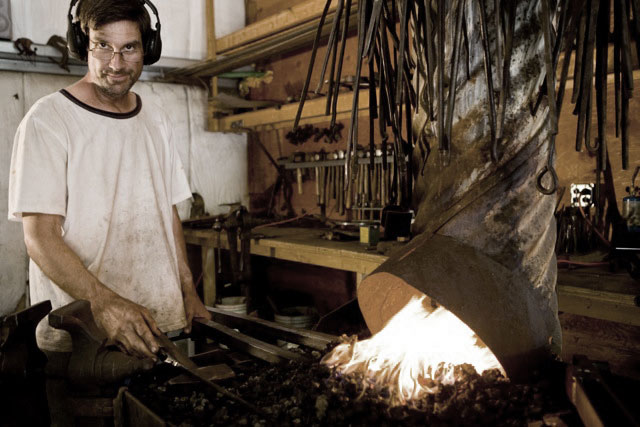A year past the close of the Pilgrim Century and some fifty-two years after the great Hammersmith Iron Works in Lynn (now Saugus), Massachusetts, went bankrupt, Deacon Shem Drowne hammered together two copper kettles into the likeness of a cockerel for the pinnacle of one of Boston’s churches. This was perhaps the point that the inhabitants of Massachusetts came to look upon smithery as not just a utilitarian trade but a form of artistry. Though his legacy endures to this day atop Faneuil Hall, embodied in the beloved grasshopper weathervane he crafted two decades after his copper cockerel, Drowne and his workshop are of course long gone, as are so very many who came after him and were winnowed away during the Industrial Revolution and at the advent of the automobile. Turn off Holmes Hole Road in Vineyard Haven onto Breakdown Lane today, however, and at the end of that unpaved spur you’ll find the workshop of a twenty-first century practitioner of Drowne’s art, the blacksmithing and metals studio of Whitney Hanschka.
Walk around oblong crates, sway-backed with weight, and clear the mouth of the bay, and you’re greeted with a bit of oily air and a metallic aroma not unlike blood. Among the few modern exceptions in a room crammed with machinery and implements held over from the last two centuries are an arc welder tucked under shelving and an acetylene torch slung beside its tanks. Resting on the cement floor near the middle of the space is the ambassador of the studio, a cast-iron hulk with a great belt-driven wheel for a head and a fifty-pound ram with which to shake hands. This is an old Star Foundry Company power hammer which, when not intimidating visitors, acts as Hanschka’s apprentice by battering shapes and textures into steel and bronze with a machine gun–pistoning action. Just behind this machine, a chimney fashioned from corrugated culvert pipe rises from a small forge. Over the dead coals, a ring of tongs hangs in wait for the next ignition. Beyond the forge, anvils the size of small engine blocks sit on the floor. Beside them, racks of hammers hang over a long workbench strewn with tools, scraps of metal, dowels, and pieces of dusty wood.
Across the space from the workbench, a tabletop of inch-thick steel plate sits on a simple frame and heavy steel castors. The smith himself hunches on a stool at one end. Despite the white creeping into his hair, his hard-tempered figure presents an affront to the aging process, hearkening back to the stanzas of vigor Longfellow penned one hundred and seventy-five years ago in his ballad, “The Village Blacksmith.”
At his feet, a massive steel vise is bolted beneath the table on a swing arm. Distinct among its raised letters is Athol, the Massachusetts town where it was cast. Spread over the surface of the table are straight edges, a compass, bolts, railing mounts, a spiral-bound notebook, and a length of pipe. But it’s what is beneath these things that offers proof of the true depth of Mr. Hanschka’s genius. Hatched strokes, parallel lines, arrows, curves, and numerals all rendered with a filigree fineness reveal that the entire table is a bluish-gray canvas for draftsmanship. At his stool, Mr. Hanschka races an ivory pencil over the steel, as he has done scores and scores of times before, to sketch out schematics for fences, gates, railings, furniture, fireplace trappings, and a host of other objects, both practical and whimsical. Bright as he is, whatever he drafts he seldom needs to articulate; throughout the studio his hands do the talking.





Leave a reply